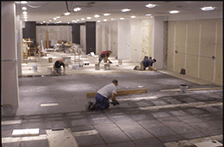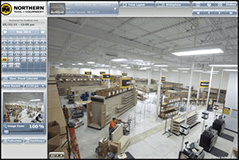Interior build-outs in the retail sector can be some of the most expensive construction projects, with cost per unit area far exceeding that of an exterior build. They’re also often more logistically complex. For example, coordination of all the different trades and the delivery of materials, fixtures, and products is key to ensuring quality, containing costs, and avoiding delays.

The ability to remotely monitor, document, and review progress at any time and from any location simplifies managing virtually every facet of an interior project. And by serving the interests of everyone from the owner and investor to the architect and general contractor, the potential return on investment is compelling.
Optimize site visits
Designers, vendors, project managers, owners all need to stay abreast of what’s happening. Every visit to the job site, however, adds to the cost of the job in terms of both time and money. Typically there are two reasons for site visits. They are either done on a regular schedule or as the result of some issue that needs attention.
Visiting the site on a regular schedule makes sense. But if it’s not tied to the activity, it’s not optimal. Executing a construction project isn’t a linear process. Some parts of the project are more complicated or more critical than others. Using construction cameras to track progress allows everyone on the team to optimize their time by visiting the site less often when it’s not as critical and more often when it is.
Visiting the site to see what the current status is and resolve issues is important. But site visits alone don’t provide a day-to-day understanding of what is happening and what has happened at the job site. Every decision delayed for a visit or made on limited information can impact the quality and schedule of the project. Using construction cameras allows for an always-up-to-date understanding and that knowledge frequently allows for faster and better decisions to be made.
Errors are avoided or caught earlier and corrected faster. Even with close attention to detail, mistakes happen. With so many eyes on the project, however, they’re more likely to be discovered and corrected early. For example, construction cameras on an interior build for a mobile device retailer allowed a remote project team member to see that power was being installed at the wrong height for incoming fixtures. The error was quickly corrected, avoiding the delays and costs of having the fixture installation crew on-site but not able to work.

Tracking progress facilitates just-in-time delivery
Workspaces on interior projects can be hectic and crowded, with several trades – each with several crew members – all working at once. The risk of accidental damage to building materials, fixtures, and product is minimized when they’re not on-site until needed.
Regular progress monitoring via a construction webcam allows planners to schedule deliveries and coordinate installation according to the pace of the project. This not only protects materials – and workers – it also makes for a neater, more efficient workspace.
Visual documentation enhances transparency and communication
When all stakeholders and decision-makers have access to the same information – the same images and time-lapse movies – issues and inquiries get resolved faster. This goes a long way in avoiding delays and keeping the project on schedule. For a retailer whose new store generates thousands of dollars of sales per day, opening on time, even ahead of schedule, is an appealing value proposition.